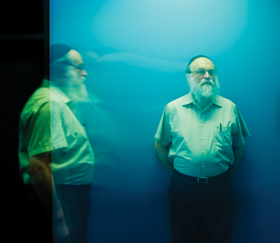Mathematician by day, novelist by night

No one could ever accuse Abraham Boyarsky, a professor in Concordia’s Department of Mathematics and Statistics, of being unproductive. He’s published five novels (with two more in the works), he’s written 26 short stories, and he’s authored or co-authored 150 research papers. He’s also the father of 13.
Following the publication of his fifth novel, Inverse Images (Mosaic Press), which chronicles the adventures of a Hasidic Jew, the Journal interviewed Boyarsky about his prolific writing career. How does he do it all? Here’s our Q & A:
Q: Your 2006 novel The Ratcatcher explored Montreal’s diversity. And Joseph Rosenblatt, the protagonist in your latest book, is also well-travelled and worldly. Between your commitments to work, family and community, how are you able to explore these different worlds?
A: I know a lot about life outside the community because I was not at all religious until I was 26 years old. And as a professor of mathematics, I am always meeting people. It was no problem over the years to live in both worlds at the same time. Duality is an essential part of existence. I’m over 60 but play badminton regularly with people in their 20s. I don’t feel any older than my students. I think I can relate to them very well.
Q: Inverse Images shows the strengths of the Hasidic community, but it also shows some serious faults, notably in the educational system. How does your community react to your novels? Do they ever get you in hot water, like Dr. Rosenblatt?
A: I think very, very few of the people in my community read novels. Those that do come from an academic background and know what I’m writing about. For hard-liners, my novel would be viewed as very upsetting. But most of them have never had a secular education. For them reading a novel is a waste of time.
Q: Your biggest influences are Franz Kafka, Fyodor Dostoevsky, Ivan Turgenev, Leo Tolstoy and Isaak Babel. But Inverse Images feels modern (particularly the youthful voice of Donna, the student Rosenblatt is having a flirtatious email relationship with). Were there any more modern influences for the book?
A: I don’t have very much time to read. I have not read modern novels.
Q: Is it true that you mostly write in the summer, at your cottage in the Laurentians?
A: This novel took three summers. I take a lot of notes throughout the year. Most of my ideas come on the Sabbath when I’m not allowed to write. I use my kids as tape recorders for ideas. I’ll say, “You remember this word, and you remember this word.” It works! I’m gushing with ideas. I’m always scribbling notes on the backs of tickets and things like that. Right now I’m working on two new novels at the same time. I’m making notes and getting ready to write in the summer.
Q: You have a glossary at the end of the novel with Hebrew words. Are non-Jews expected to understand Inverse Images?
A: My intention is to reach a wide audience. I want to show the rich diversity of Hasidic community life. There are benefits to the warmth of a community. Sometimes I think you can’t have a rich social existence without a religious connection. What’s going to keep you close to your friends, the Super Bowl and vacations?
Q: How do you find the time to write?
A: I’ve always wanted to be a writer and, thank God, I do have energy. I’m always thinking about my novels, and I make time for scribbling. It’s not so much the number of hours available. It’s how lucky and blessed you are in the little time you do have.